
Bitcoin whales’ strategy did not change much during recent crypto market collapse
According to data from the crypto analysis agency glass knot, Bitcoin whales – those holding more than 1,000 BTC – are not changing their ways at the time of the current crypto market capitulation and have traditionally accumulated large amounts in their wallets. These subjects are acting aggressively and buying an average of 140,000 BTC each month directly from the exchanges. Such dynamics led to a concentration of 45.6% of the total Bitcoin supply in whale wallets, which equates to 8.69 million BTC.
Bitcoin accumulation by whales began in April and increased until late June, when the price per BTC reached the $20,000 range. Meanwhile, the accumulation rate has already exceeded the size of the second half of both 2020 and 2021 but lags behind the first half of 2021. The concentration of 8.69 million BTC, or 45.6%, of the total supply can be considered a historical mark, which, judging by the trend and aggressive strategy of major market players, may soon be overcome.
life in the crypto ocean
It’s unclear if at least 50% of BTC’s supply will be accumulated before the capitulation is over and new momentum begins, but it’s safe to say that Bitcoin whales now have more influence in the process, and this can hardly be considered a good signal. .
At the same time, according to the same Glassnode tweets, whales are not alone in aggressively buying Bitcoin. Thus, minority holders with wallets of less than 1 BTC, amusingly referred to as shrimps, are also intensively accumulating at a pace not seen since March 2020. Due to the stats, shrimps purchase an average of 36,750 BTC per month and currently control 1.12 million BTC, which equates to 5.87% of the total supply.
Apparently, however, not all shrimp are involved in the process, because in the cryptocurrency market like in the ocean, whales eat shrimp, and if all shrimp were buying Bitcoin, there would be no nothing left for the whales to eat.


















